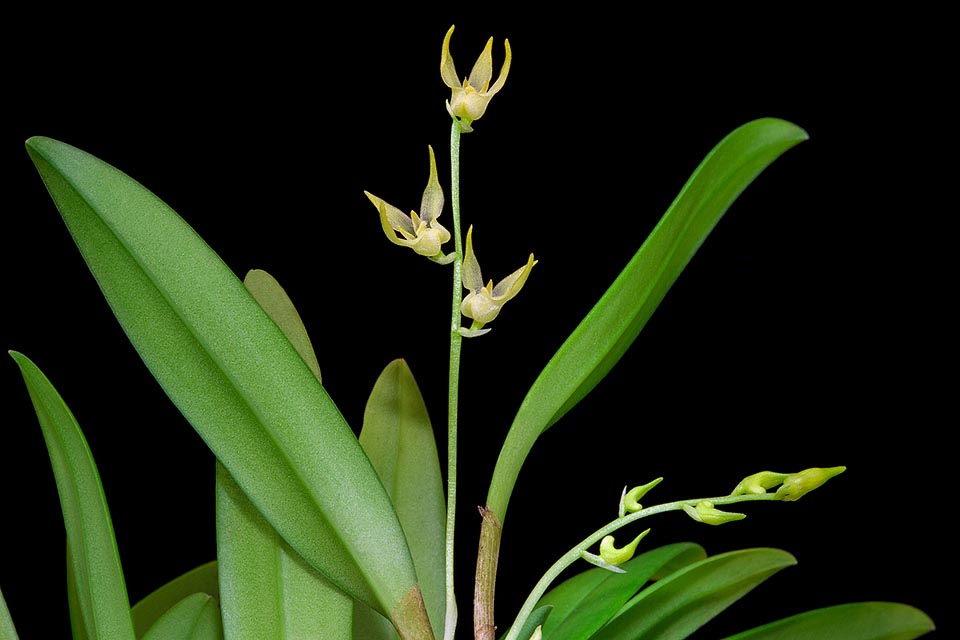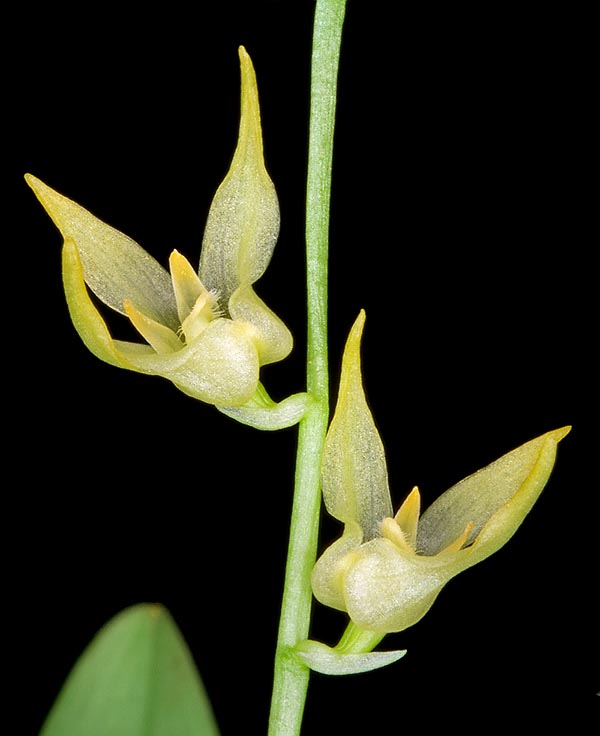Family : Orchidaceae

Text © Pietro Puccio

English translation by Mario Beltramini

Frequent in the humis South-East Asian forests, Bulbophyllum flavescens is a very variable epiphyte with tiny close pseudobulbs on a creeping rhizome © Giuseppe Mazza
The name of the genus is the combination of the Greek substantives “βολβός” (bolbos) = bulb and “φύλλον” (phyllon) = leaf, with reference to the leaves growing at the apex of the pseudobulbs; the name of the species is the present participle of the Latin verb “flavescere” = to become yellow, with reference to the colour of the flowers.
Common names: yellowish bulbophyllum (English).
The Bulbophyllum flavescens (Blume) Lindl. (1830) is an very variable epiphytic species that forms wide tufts, on the trunk as well as on the main branches of the trees, with tiny close pseudobulbs on a creeping rhizome.

Inflorescences with tiny pale yellow flowers of about 2 cm of diameter © Giuseppe Mazza
Racemose inflorescence, on a thin 3-8 cm long scape, bearing numerous tiny flowers, of about 2 cm of diameter, of pale yellow colour with pale orange apex of the labellum. Lanceolate dorsal sepal with caudate apex, concave, 0,7-0,8 cm long, lanceolate lateral sepals with acute or caudate apex slightly longer than the dorsal one, united at the base of the column to form a sort of a spur (mentum), linear-lanceolate petals with acute apex, about 3 mm long and 1 mm broad, ovate labellum with obtuse apex and ciliate margins, abruptly bent at the centre, about 3 mm long and 1 mm broad, and column with bifurcated apex.
It reproduces by seed, in vitro, and by division, with each section provided of at least 3-4 pseudobulbs, at the vegetative restart.
Floriferous and easy to cultivate miniature orchid, requires a partial shade, medium-high temperatures in summer, 20-30 °C, slightly cooler in winter, with lowest night ones not under the 15 °C, high humidity, 70-80%, and constant ventilation.
The plants mounted on trunks or rafts are to be watered and nebulized frequently, utilizing rain water, demineralized or by reverse osmosis at ambient temperature.
The waterings must be more reduced, in order to allow the substratum to partly dry up, for the plants cultivated in pots or baskets. Fertilizations every two weeks from spring to autumn, monthly in winter, utilizing a balanced hydrosoluble product, with microelements, at 1/4 the dosege shown on the package.
The species is reported in the appendix II of the CITES (species whose trade is internationally ruled).
Synonyms: Diphyes flavescens Blume (1825); Bulbophyllum adenopetalum Lindl. (1842); Phyllorchis adenopetala (Lindl.) Kuntze (1891); Phyllorchis flavescens (Lindl.) Kuntze (1891); Phyllorkis adenopetala (Lindl.) Kuntze (1891); Phyllorkis flavescens (Blume) Kuntze (1891); Bulbophyllum montigenum Ridl. (1894); Bulbophyllum puberulum Ridl. (1896); Bulbophyllum barrinum Ridl. (1912); Bulbophyllum ramosii Ames (1912); Bulbophyllum lanceolatum Ames & C.Schweinf. (1920); Bulbophyllum exiliscapum J.J.Sm. (1927).
→ For general notions about ORCHIDACEAE please click here.
